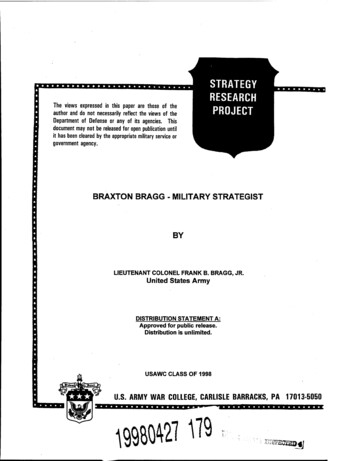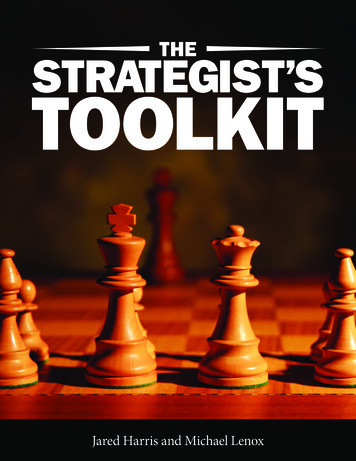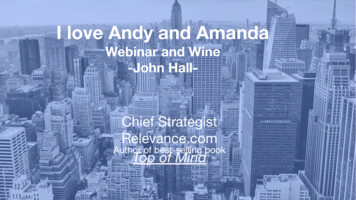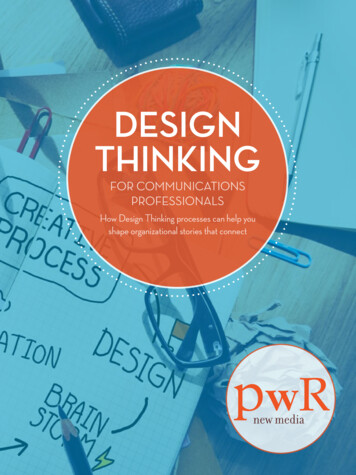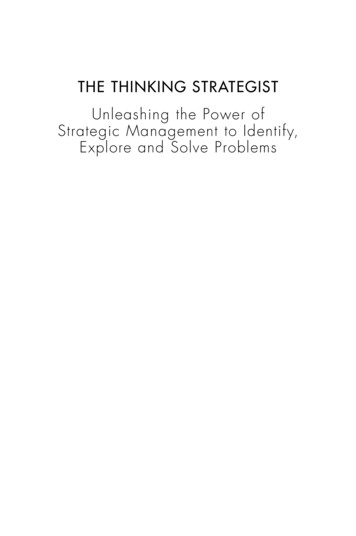
Transcription
THE THINKING STRATEGISTUnleashing the Power ofStrategic Management to Identify,Explore and Solve Problems
This page intentionally left blank
THE THINKING STRATEGISTUnleashing the Power of StrategicManagement to Identify, Exploreand Solve ProblemsByVickie Cox EdmondsonUniversity of Georgia, USAUnited Kingdom – North America – JapanIndia – Malaysia – China
Emerald Publishing LimitedHoward House, Wagon Lane, Bingley BD16 1WA, UKFirst edition 2018Copyright 2018 Emerald Publishing LimitedReprints and permissions serviceContact: permissions@emeraldinsight.comNo part of this book may be reproduced, stored in a retrieval system, transmittedin any form or by any means electronic, mechanical, photocopying, recording orotherwise without either the prior written permission of the publisher or a licencepermitting restricted copying issued in the UK by The Copyright Licensing Agencyand in the USA by The Copyright Clearance Center. Any opinions expressed inthe chapters are those of the authors. Whilst Emerald makes every effort to ensurethe quality and accuracy of its content, Emerald makes no representation impliedor otherwise, as to the chapters’ suitability and application and disclaims anywarranties, express or implied, to their use.British Library Cataloguing in Publication DataA catalogue record for this book is available from the British LibraryISBN: 978-1-78756-158-8 (Print)ISBN: 978-1-78756-157-1 (Online)ISBN: 978-1-78756-159-5 (Epub)
AcknowledgementI wrote this book to disseminate business knowledge and to promote highlevels of achievement among leaders with disciplined minds who seek tochange the world. First, I express my sincere appreciation to my highlyengaged students, faculty, and colleagues at the University of Georgia (UGA),the University of Alabama at Birmingham (UAB), Morehouse College, andTuskegee University. Over the years, they have forced me to make toughdecisions and deliver on my promises. I appreciate all who have supportedmy efforts to bring tough love and raised expectations to management classrooms. Learner success is paramount to my work.Next, I want to thank the people at Emerald Publishing Group for t akinga chance on me. Special thanks to Pete Baker, the editorial assistants, thereviewers, those responsible for the marketing of my book – all whoseinsights helped to shape The Thinking Strategist and make it applicable toreaders beyond the business capstone.Moreover, I want to thank David A. Thomas, the 12th President of Morehouse College, for writing a compelling and inspiring foreword. I certainlymust express my gratitude to Garikai Campbell, the Provost at Morehousewho gave me an opportunity to be a difference maker at the senior administrative level. I also want to thank the many business and organizationalleaders who have given me a voice in developing their business model. Myhope is that my proposed strategies made you think and grow as leaders.Thanks for being open to my constant “contributions.” Thank You. ThankYou. Thank You.Lastly, I want to express my love and appreciation to my three intelligent,beautiful and loving legacy daughters: Shantori, Devon, and Brandy, amazing women who provide ample learning opportunities for me to grow, andmy two granddaughters, Atia and Fiori, who will keep me on my toes foryears to come. I can’t forget my family and friends, for sure too many tocount, who encourage me to reach for the stars.v
This page intentionally left blank
CONTENTSAbout the Author xiiForeword xiiiPART ONE: SETTING EXPECTATIONSSection A: See Yourself at the Top1.2.3.What is Strategy and Why is it Important to Anyonenot at the Top? 5Your Professional Growth What Does it Take to Become an Expert in Strategy? How Will You Know When You Have Achieved Expert Status? 7810The Process, the Players and the Stakes 15Organizational Structure and Decision Making Stakeholders and Stakeholder Power Board of Directors Top Management Managers Empowered Problem Solvers and Contributors Other Stakeholders The Process 1517192121222426The Art of Judgment 29Emotional Intelligence and Assessment Tools Developing Emotional Intelligence Developing Better Judgment Dissent in Decision Making Accountability to Do Something 3031333334vii
ContentsviiiSection B: Business Acumen4.5.Problem not Currently Solved 39Industry Business Mission Strategic Vision Strategic Thinking to Analyze the Situation 41424344Criteria for Good Strategy 47Change and Innovation: A Willingness to Act on Thoughts Ways to Introduce Change Reactions to Change Achieve Goals, Meet Objectives Financial and Strategic Performance Objectives Crafting Strategy for Competition and Sustainability Leveraging Competitive Advantage andDisadvantage for an Edge Resources or Constraints Evaluation and Control 474950505254555656PART TWO: THE VAULTSection A: Taking Stock1.2.Gathering Information with a Shared Goal in Mind 63Search with a Shared Goal in Mind Fact Check Benchmark Based upon Strategic Groups Pay Attention to Numbers Get Ready to Think: What You Think Really Matters Handling Stakeholder Need for Confidentiality Willingness to Accept the Findings 64646565666869What Does a Company’s Internal Environment Revealabout its Strategy – Structure Relationship? 71Present Strategy Analysis Functional Areas of Business Analysis Competitive Financial Analysis Identifying Firm Strengths and Weaknesses 73747676
Contents3.4.ixEvaluating a Company’s External Environment:The Firm Industry–Society Relationship 79Six Segment General Environment Analysis External Driving Forces Analysis Forces Driving Industry Competition and Attractiveness Stakeholder Analysis Comprehensive Driving Forces Analysis SWOT Analysis An Overview of Skye Construction Environmental Factors 8082838485858889Gaining Alignment on What is Happening and Why 93Findings from Skye Construction Key Notes from the Brainstorming Sessions The Follow-up Meeting External Facing CRT Five Key Points 9696979899Section B: Crafting Strategy for Competitive Advantage5.6.Theory Linking Strategy to Performance Objectives 103Three Levels of Strategy Strategy Typologies Objectives-based Strategies Flexibility and Emergent Strategy 105105107109Strategies for Overcoming Constraints 111The no Immediate Change/Active Waiting Option Strategic Adjustments Strategic Cost Alignment Synergistic Development Firm Growth/Diversification Collective Strategy Partnering or Doing Business with Minority BusinessEnterprises Caveats Building Links with Business Schools 111112113116116118118121121
Contentsx7. Brainstorming and Collaborative Decision Making Brainstorming Agreement on the Important Issues Decision Analysis Decision Modes Findings from Skye Construction 123123125129131132Section C. Organizational Learning throughStrategy Implementation8. Linking Implementation to Objectives Risk Management and Sticking to the Plan Avoiding Potential Problems Legend for Implementation Planning Findings from Skye Construction Skye Construction 1431461471491501529. Managing Talent, Time, and Money 159The Who Matters: Assessing Talent Setting Realistic Time Expectations Staying within Budget Testing Plan Objectives Findings from Skye Construction Testing the Talent Objective Testing the Time Objective Time Commitment Schedule Testing the Budget Objective 16016216416516516516716917110. The Art of Gaining Commitment by Raising the Stakes Web Conferencing Face-to-Face Meetings Presenting the Meeting Content Storytelling Use of Examples A Supporting Functional Analysis Value of Visuals Tables, Charts, Graphs, Displays,and Pictures Use of Appendix and Summary Handout Citations and Sources 173174174176176178179180181182
ContentsxiSection D: Assessing Progress And Impact11. Strategy Evaluation and Control Identifying and Recording Deviations from Planned Results Accountability Common Financial Terms Financial Statements Caveats about Financial Ratios Key Financial Ratios for Analyzing a Company’s Strengthsand Weaknesses Additional Tools 12. Strategic Communications Messaging Communication Functions The Process KISS the Message Process Mapping and Modeling Just in Time Communication Commit to the Strategic Management Process Now Go Do Great Things and Celebrate 4Appendix 207References 217Index 221
ABOUT THE AUTHORVickie Cox Edmondson, Professor of Management, has taught strategic management, a business capstone course, since 1994. Prior to joining TuskegeeUniversity in fall 2018, she taught the course for seven years at MorehouseCollege where she served as the first Associate Provost for Student Success.Dr. Cox Edmondson taught the course at the University of Alabama at Birmingham in an academic appointment for 15 years, and at the University ofGeorgia while pursuing a doctorate degree in the discipline.Dr Cox Edmondson has written and coauthored academic and trade articles,book cases, and chapters. Her teaching, research, and consulting interests are instrategic management, business ethics, race and diversity issues in organizations,organizational change, and the critical voice. Her work has been published inAcademy of Management Learning and Education, Business and Society; Journalof Business Ethics, Equality, Diversity, and Inclusion; Journal of OrganizationalChange Management; Journal of Communication Management, and others.A captivating academic and management strategist, Vickie Cox Edmondson graduated cum laude from Spelman College with a BA in English. Sheholds a PhD in strategic management from the University of Georgia and anMBA from Mercer University. Bringing more than 20 years of industry experience, including business consulting, and senior level and board leadershipin a nonprofit, to the classroom, Dr. Cox Edmondson is known as a challenging professor whose ultimate aim is to provide learners with the necessaryskills to excel in business endeavors and advance in their careers.Vickie co-founded and served as the Executive Director of Follow MeFoundation, Inc., a nonprofit established to help economically disadvantagedyouth in her hometown community of Carroll County, Georgia. She alsoserves on the board of directors for Saint Smyrna Baptist Church in Newnan,Georgia and is a life member of Sigma Gamma Rho Sorority, Inc.Dr Vickie Cox Edmondson is the mother of three daughters. She enjoys traveling, socializing, and assessing the world around her for additional opportunities.xii
FOREWORDToday, we live in what some futurists have coined a VUCA world. A worldthat is volatile, uncertain, complex, and ambiguous. Responding effectivelyin this world requires that decisions be made closer to the frontline activityof organizations. How can this happen without creating chaos throughoutorganizations?The answer is to have employees at every level able to think strategicallyabout how to respond to conditions on the ground and in real time. This doesnot mean expanding strategic planning departments. It means developingmore employees and especially frontline managers who can think strategically.In the latter half of the twentieth century a combination of business academics, corporate executives at America’s largest companies and leadingconsulting firms developed a set of reliable tools for setting strategy. Theseincluded the necessity to understand the organization’s relationship to itsenvironment, map its stakeholders, determine goals, and define how theorganization competes and differentiates itself in the marketplace.Organizations such as GE, GM, Citi, and IBM created large strategicplanning departments that took up the task of defining strategy for theirfirms with five- and 10-year horizons. To staff these departments, these companies hired the best and brightest from top tier colleges such as Morehouse,Harvard, Yale, Howard, and Stanford. They also recruited talent out-of-toptier consulting firms such McKinsey and BCG. Possessing their understanding of corporate strategy and the tools to set it, these individuals becamevalued employees. Many went on to lead major business units, not becausethey were technical experts but because they understood how to think strategically about the business.The unspoken assumption was that companies only needed a few people who could think strategically. Strategic business decisions had long-termhorizons. Only an elite group of managers defined by their intelligence andpossession of the tools of strategic thinking were needed. They would sit atxiii
Forewordxivthe top of the corporate pyramid. This logic seemed supported by the riseand stability of large corporate behemoths in the latter half of the twentiethcentury.Some realities of the marketplace for products and labor supported thisview. Markets were relatively stable and innovation was slow. New productsthat seemed to capture the imagination of consumers could expect to last foryears. A prime example was the mainframe computer. Few could imaginethat one day we would have on our phones as much computing power asexisted in the 3,000 sq. ft buildings that housed mainframes. Other exampleswere Xerox copiers, AT&T’s long-distance telephone service, and the globalreach of companies like Citibank. These marketplaces and companies werecomplex, but they were not volatile, uncertain, or ambiguous.Labor markets mirrored this complex, but stable and slow changing environment. Career success was largely defined by earning a place on the professional and managerial hierarchy of one of these large corporations andriding the escalator up to management and eventually retirement. Careerpaths were long and orderly. A resume that showed employment in multiplefirms was suspect.This reality began to unravel with accelerating speed in the last two decades of the twentieth century and is not recognizable today. The competitiveadvantage of new technology today lasts less than a year before it is copiedor matched and overcome by new innovation. The Internet has made pricesso transparent that cost advantage lasts less than a day, think airline tickets. Customers are less and less captive to services, think telephone numberswhich are now owned by the consumer not the phone company.A parallel unraveling has happened with labor markets. The social contract between companies and employees no longer exchanges loyalty for jobsecurity and longevity. Employees demand that companies increase the portability of their human capital. Most individuals will work for multiple companies before they reach retirement.This new environment is requiring companies to delegate decision rightsto those closer to the frontline where employees and customers meet. It isalso demanding that employees throughout the firm know how to think strategically. Most important is that the ability to think strategically will becomea skill set by which employees will be selected and evaluated for selectionand advancement.
ForewordxvThe Thinking Strategist is the first book to address this reality. It describesthe tools of strategy making in an accessible way. Professor Vickie CoxEdmondson makes a compelling case for why being a thinking strategist isnecessary whether you are a senior manager trying to break through to thenext level or a person early in your career.David A. Thomas,Prominent Management Scholar AndThe 12th President Of Morehouse College
PART ONESETTING EXPECTATIONS
This page intentionally left blank
SECTION ASEE YOURSELF AT THE TOPWould you like to be considered one of the most widely sought after candidates for a position in your company or chosen field, for entrance into topgraduate and professional schools in the world, or someone destined to makeyour mark as an entrepreneur or a leader in causes and movements that matter to you? Are you willing to put in the work to achieve that level of success?Don’t waste your time with this book if you are not. Reading it may makeyou believe you can achieve success if you can recall or refer back to the keypoints, but you won’t know how good you can really be until you believethe advice and tools found within can open doors for you. Once you put inthe work, you will be more empowered to achieve your hopes, dreams, andaspirations even if being at the top is not one of your goals.3
This page intentionally left blank
1WHAT IS STRATEGY AND WHYIS IT IMPORTANT TO ANYONENOT AT THE TOP?In business, products or services are offered for sale or used more often thannot by more than one manufacturer, seller, or merchandiser. Competitionamong firms in an industry can be fierce. The moves and approaches used toentice employees, investors, customers, and clients to respond more favorably to your business and products and services than to the competition arereferred to as strategy. The moves and approaches used to position your business for growth are referred to as strategy. The moves and approaches usedto respond to threats in the industry are referred to as strategy. Strategy canbe defined as a set of decisions, approaches, and actions aimed at successfullymeeting financial and strategic objectives over time. Objectives are countlessand may vary from year to year and change from leadership team to leadership team (Fig. 1). Many of the decisions are made at the top, therefore, youmight ask, “Why is strategy important for those who are not at the top?” and“Why should I become an expert at strategy well before I am in position todetermine strategy?”While many of the final decisions are made at the top, many intermediate decisions are made throughout the organization and well before a setof recommended actions are brought to the attention of top managementfor consideration (Fig. 2). For example, top management may decide whichnew widgets will be produced in the upcoming year. However, there aremany factors about each widget and its capacity to help a company successfully compete against other firms that must be determined well beforethe new product conceptions are presented to the decision-makers – those5
The Thinking Strategist6Fig. 1: Hierarchical Management Structure with Strategic Business.BoardPresidentYourpicturehere today.VP SBU 1VP SBU 2VP SBU 3MGRMGRMGRReportsYouReportsReportsFig. 2: Flat Management Structure for a Small Entrepreneurial Ventureor Single Business le in a company that are considered experts and are ultimately responsible for the success of a company. Imagine you are observing a comparativepresentation where the decision-makers consider which new products, ifany, they will support. More than likely, you will observe some of the decision-makers ask probing questions that help to determine which productor products to select. Some decision-makers will make comments that mayadjust the thinking of the presenters as well as the other decision-makers.
What is Strategy and Why is it Important?7Someone may display an unwillingness to change and must be coached fora change of position.YOUR PROFESSIONAL GROWTHWhile observing strategic decision-making in action could be enlightening andquite motivational, waiting until you are in a position to “set” or determinethe final strategy is too late to develop distinctive competencies in strategicthinking and decision making. The sooner you begin to use intentional strategies in your work life, the easier it will be to handle the role of setting strategy for a firm once the competencies are needed. As a contributor, you willbe judged on your ability to make better decisions and solve problems beforethey occur. The quality of your input can help you get noticed and consideredfor promotions sooner than your colleagues. At the core of this book is thegoal to help you develop the skills that will allow you to be a skillful decision maker as well as a driver of decision making – an expert, a thinking strategist.Business coaches Graham Alexander, Alan Fine, and Sir John Whitmoredeveloped the GROW Model in the 1980s as a coaching model. Their modelhas been adapted over the years (Fine & Merrill, 2010). The adaptation belowwill serve as a guide for your professional development throughout this book: Goal setting (what do you personally want to achieve and how does ithelp the organization) Reality (is the goal attainable, what obstacles must you overcome, andhow long will it take you to get there) Opportunities (what conditions are favorable for you) Way forward (what is your success strategy)A success journal can help you develop your thinking process and trackhow you make success happen so that you can help others. To help you alongthe way, I included some suggested journal entries. Don’t stop with those.Descriptions of any incident that supports or questions your assumptionsand beliefs should be added to the journal.As posited by the Department of Health and Human Services (a department of the US government whose aim is to help those who are least able to
The Thinking Strategist8help themselves) as you gain more opportunities, you are expected to contribute more to the organization and to the proficiency of others in order tofacilitate either action or a decision. Leadership competencies include: Expert: models, leads, trains, and motivates multiple levels of personnelto be excellent in decisiveness. Advanced: even in the most difficult situations recognizes problems oropportunities and determines whether action is needed, takes charge ofa group when it is necessary to facilitate a decision, and makes decisionsin a timely manner under ambiguous circumstances and when thereexists considerable risk. Proficient: usually recognizes problems or opportunities and determineswhether action is needed, takes charge of a group when it is necessaryto facilitate a decision, and makes decisions in a timely manner underambiguous circumstances and when there exists considerable risk. Novice: demonstrates common knowledge or understanding of beingdecisive, but may avoid or miss opportunities to make decisions in atimely manner. Sometimes considers consequences and risks in order toassess the timing for a decision, uses clear criteria for and includesothers in the decision-making process, and makes decisions in a timelymanner when the options and consequences are clear (Fig. 3).Few people become experts. However, the more expertise you have themore game changing opportunities you have.WHAT DOES IT TAKE TO BECOME AN EXPERT IN STRATEGY?Before we think about what it takes to be an expert, let us consider some ofthe things it takes to be proficient through the lens of mathematicians Fuson,Kalchman, and Bransford (2005): Conceptual understanding: comprehension of concepts and theory ofhow they relate to one another. Skill fluency: skill in carrying out the phases of strategy making flexibly,accurately, efficiently, and appropriately.
What is Strategy and Why is it Important?9Fig. 3: The Skill–Opportunity itiesMoreOpportunitiesMeaningfulOpportunitiesGame ChangingOpportunities Adaptive reasoning: capacity for rational thought, reflection, explanation,and justification based on data in addition to natural instinct and intuition. Productive disposition: inclination to perceive the process as sensible,useful, and worthwhile, coupled with a commitment learn and grow.Simply put, two interrelated factors will determine your success in crafting strategy:1. Having Realistic Expectations of SuccessExpectations guide rational thinking. When we look into the long-term success of any organization, there is a positive correlation between its key players’ ability to craft and implement appropriate strategies to solve problems
The Thinking Strategist10and the organization’s long-term success. It seems obvious that the strategies developed by organizations have been undertaken with a sincere beliefthat their successful implementation will improve the situation. In fact, onecan easily say that it is illogical and improbable that decision-makers mightintentionally craft strategies they believe will make the situation worse. It is,therefore, safe to assume that any change is undertaken with the expectation of improving or limiting the negative impact of an issue to positivelyaffect the performance of the organization. While we can agree on the goodintentions of decision-makers and everyone involved in the strategy-makingprocess, a strong look at the results of their actions tends to present anotherpicture – one of less than optimal results.2. Learning from Repeated PracticeWithout question, the primary way to develop competency as a thinkingstrategist is to intentionally and actively participate in the strategy-makingprocess. No matter how many articles and books you read, how many casestudies you analyze, how many discussions over coffee you have with experts,and how many times you watch someone else do something you want tolearn to do well, to become an expert you must do the thing you want tolearn and learn from that experience (analyzing what went as expected, whatwent better than expected, and what did not go as expected). You must practice as often as necessary – learning from each experience and making necessary adjustments based on the previous incident. With each decision-makingopportunity, you can integrate the new knowledge and skills as part of yournatural style. Moreover, once you become skilled, the expectation is that youwill help others succeed in becoming skilled. Thus, a company benefits fromhaving more thinking strategists because of your efforts.HOW WILL YOU KNOW WHEN YOU HAVE ACHIEVEDEXPERT STATUS?Inherent to expert status is the idea of a comparison to others, or relevantstrength. Articles and books will help you learn the vocabulary and perhapsensure you know in which context the terminology is used or how the tactic
What is Strategy and Why is it Important?11should work. However, as in any competition, until you get into the game,you won’t know how good you are in comparison to others.Let us go back to the meeting where the decision-makers are considering which widgets to produce in the upcoming year. A thinking strategistwill pay attention to the presenters’ communication style, the content oftheir presentation, the process they use to present the information, etc.Attention would also be paid to the decision-makers’ understanding andappreciation of the presentation content, their engagement with the presenters, and their willingness to objectively compare all of the widgetsunder consideration. The thinking strategist is pondering which presentersare experts at what they do for the firm and what competencies should beemulated or modeled throughout the firm. There may be some thought asto how some people were selected as decision-makers if their contributionsare not meaningful.A signal that you are NOT an expert is when you realize that you do notobjectively compare well to those whom you have determined to be experts.Certainly, your assessment of the decision-makers’ competencies may differ from others as your direct knowledge of their knowledge, skills, andcontributions to a company may be limited. However, an introspective selfassessment of your competencies will reveal areas for improvement that onlyyou can confirm or deny.You will know you are becoming an expert when you are invited tothe decision-making table as a member of your work group or to represent your work group. Your work output has shown signs that you are acontributor worthy of closer attention – based on your knowledge of theinternal and external environment of business, your attention to detail,creativity, innovation, and a willingness to change the status quo, etc.When you are at the decision-making table, you now have an edge thatwill allow you to become more proficient and thus, more valuable to acompany. You will become a go-to resource for others in a company andperhaps the industry.Likewise, you will know you are becoming an expert when your networkincludes key decision-makers throughout the organization. Intentionally,build your support network by connecting with others with similar goalsand interests. Learn what others do in your department and your company.Invest in their success. Connect with colleagues and others in your industryto learn more about different functions that can help you develop your competency to problem solve.
The Thinking Strategist12This book seeks to provide business students and aspiring decision-makerswith an overview of what it takes to be an expert in the strategic managementprocess. Given that learners differ in the ways that they perceive and comprehend information, not everyone achieves expert status at the same rate. Manypeople find the competencies hard to attain, regardless of how often they practice or are invited to the table. Moreover, someone can be an expert in onephase and a novice in another. However, most succeed, to varying degrees. Thebetter you become at setting yourself apart for making a difference for others –not just yourself, the more opportunities you get to contribute.As shown below, there are countless opportunities for you to contributein the strategy-making process. The process will be introduced in Chapter 2,and each phase will be discussed further in Part two. As you move throughthe process, it will become increasingly clear that it is not a linear step-by-stepprocess and that the amount of time required for each phase differs. Moreover, depending on who is at the table, conducting some processes is morechallenging than others are. Nonetheless, each phase is necessary for optimalperformance, and you should strive to be more than proficient in each phasein order to make good contributions. Successful leaders understand that itis the collective strength (the interdependencies of factors, both positive andnegative, that determine competitive positioning) of the process and the competencies of the people utilizing the process that determine its succe
reviewers, those responsible for the marketing of my book – all whose insights helped to shape The Thinking Strategist and make it applicable to readers beyond the business capstone. Moreover, I want to thank David A. Thomas, the 12th President of More-house College, for
